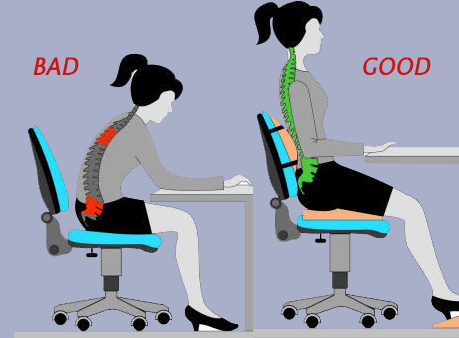Disclosure: This article may contain affiliate links. When you click these links, I may earn a small commission at no cost to you. As an Amazon Associate I earn from qualifying purchases at no cost to you. See full policy here
“Sit up straight.”
“Don’t slouch. It’s bad for you.”
“Stand up tall.”
These are phrases we have all heard from our parents and teachers as we were growing up. Well, it turns out, they were right.
As a Physical Therapist I have treated many people over the years with posture related problems. They usually come into the clinic complaining of symptoms associated with bad posture including:
- neck pain
- headaches
- upper back pain
- shoulder pain
- arm, elbow, and wrist pain
- carpal and/or cubital tunnel syndrome
- low back pain
- hip pain
What is posture?
Posture is defined as the position in which you hold your body in static positions such as sitting or standing or dynamic positions such as walking. Simply stated good posture is when your body is able to maintain alignment, stability, and balance in these positions. Bad posture occurs when your body is unable to maintain alignment, stability and balance.

For example, I walked into my husband’s office the other day and saw that he was demonstrating the three main types of bad sitting posture:
- Forward Head
- Rounded Shoulders
- Forward Hips (Anterior Pelvic Tilt)
Fixing your posture can prevent and fix headaches, back pain, neck pain, hip pain…and the list goes on and on. In this post, I’m going to provide the following information to help you reap the benefits of having a good posture while working:
- Describe the three main examples of bad posture (Give a brief description of what each type looks like)
- Explain how each type of bad posture position is affecting your body (Warn you about the negative effects the above positions may have on your body)
- Provide a simple test to see if you have any of the above abnormal posture positions
- Share some tips to correct your posture
Bad Posture Example 1: Forward Head

- This occurs when the ears do not line up with the middle of the shoulder joint due to tightness of the posterior (back) neck muscles.
- Effects: Forward Head Posture affects the muscles and ligaments of the low back, hips, and knees as it shifts the center of gravity forward.
- How to tell if you need to correct your posture: A simple test to see if your head is too far forward is to check to see if you can touch your chin to your chest. If you’re not able to do this, then you probably have a Forward Head Posture.
- How to correct this bad posture: A tip to correct this is to make sure the top of the computer screen is at eye level. It helps to make sure that your screen is an arm’s length away.
Bad Posture Example 2: Rounded Shoulders

- This occurs when the arms are pulled forward due to the anterior (front) shoulder muscles becoming tighter and shorter than the posterior (back) shoulder muscles. This causes the shoulder joint to move forward in the socket.
- Effects: This bad posture can cause pain in the front of the shoulder, especially when raising the arms upward or when performing push-ups or bench presses.
- How to tell if you need to correct your posture: Stand up and grab two pencils. Hold them parallel to each other so that the lead tips are facing away in front of you. Look at the pencils. If the tips are angled towards each other; then you probably have Rounded Shoulders.
- How to correct this bad posture: To correct this, move your chair closer to your desk, making sure the armrests can easily slide under the desk. Check to make sure your shoulders are relaxed and down. Your forearms should be level with your desk.
Bad Posture Example 3: Anterior Pelvic Tilt

- This example of bad posture often happens when you sit for the majority of your day. Your hip flexor muscles tighten and become shorter, causing your pelvis to tilt forward.
- Effects: Sitting in this position can lead to low back pain, sciatica, an increased risk for disc disease, and anterior (front) hip pain.
- How to tell if you need to correct your posture: To check for this, lay on the floor on your back with your knees bent. Next lift your butt off the floor. If you are only able to lift your butt up a few inches; then you probably have Anterior Pelvic Tilt.
- How to correct this bad posture: Make sure that your back is firmly against your chair so that you are not leaning forward.
To help you make sure check your posture every time you sit or stand at your desk, I’ve provided a checklist that you can use to achieve a better sitting or standing position:
The Essential Posture Checklist

Every time you sit or stand at your desk, go through this checklist to check your posture.
- Your head is in the neutral position (straight) and not tilted or turned.
- Your ears are aligned with the middle of your shoulder.
- Your shoulders are relaxed and down.
- Your forearms are level with the keyboard
- Your upper and lower back are in a neutral position. In a neutral position, your back forms an backward ‘S’ shape – meaning your upper back is slightly curved out, and your lower back is slightly curved in. Use a back support as needed.
- The middle of your hips should be aligned with the middle of your shoulders and inline with your knees.
- When sitting, your feet should be in front of your knees and flat on the floor. Use a footrest if needed.
In addition to checking your posture occasionally throughout the day, you should get up and move every 40-50 minutes. In a future post I will show you some amazing exercises you can do at work.
Final thoughts: Correcting your posture is not a fast process. It takes time. You can easily make changes in your workplace and enjoy the benefits of having a healthier spine and a healthier you!
Quick Disclaimer:
All content in this post is for informational purposes only. It is not intended to be diagnostic nor as a substitute for consultation, examination, and treatment by a qualified health professional. Always consult with your physician before making any lifestyle changes.






